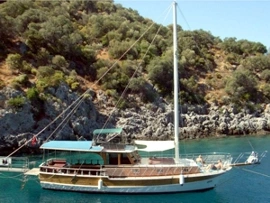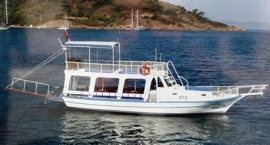Dalaman Fethiye Olu Deniz area things to do
Please browse the different places of interest below which we hope will give you some pointers on making the most from the turquoise coast area of Turkey.
Lycian Sites

The
Lycians ruled over this area of Turkey's coast from around 200 BC. Fethiye is
situated on the site of the important Lycian city of Telmessos. You will see
plenty of monuments throughout the town, the most famous being the rock tomb of
Amyntas on the south of Fethiye. Whilst walking up the hill towards the tombs,
you will see Lycian sarcophagi along the route, more Lycian sarcophagi can also
be seen by the town hall in the town centre.
Fethiye's Roman Theatre

When
the Romans occupied Turkey, they permitted the independently minded Lycians
self-rule, but this didn't prevent them from making their own mark on the
Lycian cities. Fethiye has a small partially excavated theatre that is being
reconstructed in areas which originally was built in the 2nd century BC, at a
time when Telmessos had become part of Rome's Asia Minor territory. It would
have originally seated around 6,000 spectators, by scrambling up to the top
tier of the seating rewards you with great views across the town, harbour and sea
beyond.
Fethiye Museum
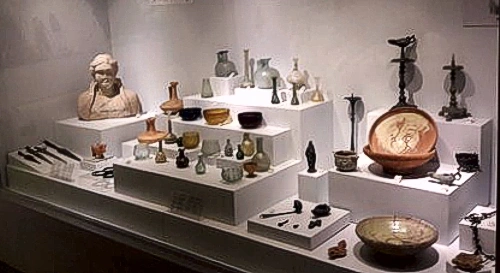
There
is a small Museum in Fethiye where you can learn about the Lycian history,
especially an bonus if you're planning to visit the attractions such as Tlos, Xanthos
and Letoön. Vivid information boards clearly explain the Lycian culture with
exhibits of pottery, jewellery, and stele slabs are attractively displayed. The
museum's pride of place is the Trilingual Stele this is inscribed with Lycian,
ancient Greek and Aramaic found whilst
excavating Letoön. This stone aided archaeologists to finally understand the
Lycian language.
Şehit Fethi Bey Park
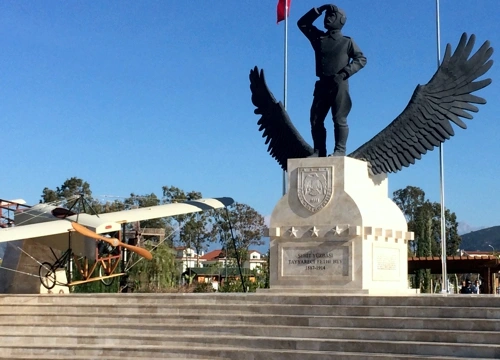
Fethiye
has a new park called Şehit Fethi Bey Parkı which offers numerous things to do and
see for the whole family and is situated right on the water front, well worth a
leisurely walk around. Fethiye is named after Şehit Fethi Bey (Fethiye is the
feminine form of Fethi). Tayyareci Fethi Bey was a famous airline pilot who was
originally from this area. In 1914, he attempted to fly from Istanbul to Cairo
in Egypt for the first time. Unfortunately, on February 27th 1914, his plane
crashed between Damascus and Jerusalem. He received the title of the air
force’s first aviation martyr (‘şehit’ means ‘martyr’ a phrase used for fallen
military personnel). The town was previously known as Telmessos and Makri and in
1934 the town’s name was changed to Fethiye in honour of Şehit Fethi Bey. Every
year on the anniversary of the death of Şehit Fethi Bey commemorations take
place by his statue which is the focal point of the park, very fitting for whom
the town of Fethiye is named after.
Ölüdeniz Blue Lagoon
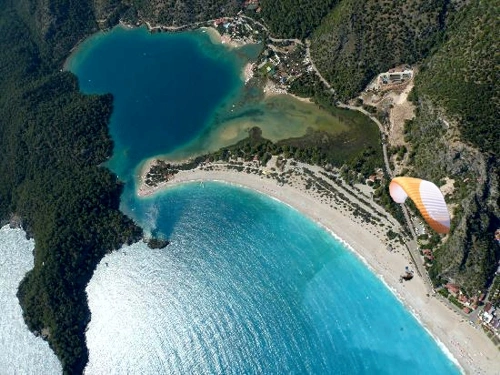
Turkey's most famous beach is 15 kilometers from Fethiye. The calm turquoise water, sheltered from the sea, with its white sand beach rimmed by dense pine forest, are impossibly perfect, which is why people have been flocking here for years now. Some of Ölüdeniz's sheen has been shaken off over the past two decades as package tourism arrived on the scene, but the lagoon area has not seen the ugly construction development of other tourism hotspots, and the village attached to the lagoon is still a low-story unobtrusive affair. If you don't want to swim or sunbathe then the other big activity here is paragliding. Mt. Baba (Baba Daǧ) dominates the scenery inland, and paragliders launch themselves off the peak throughout the summer months. Even beginners can have a go with a tandem paragliding flight.
Abandoned
Ghost Village of Kayakoy
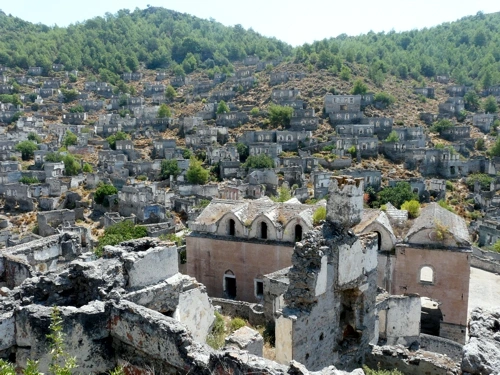
Kayaköy
(ancient Karmylassos) was until the 1920s a thriving mixed population of Greeks
and Turks having lived together for centuries. The ghost village is situated 8 kilometres
from Fethiye. The 1923 Population Exchange altered all of that, relocating
ethnic Greeks across Turkey and transporting them to live in Greece, making
ethnic Turks who lived in Greece abandon their lives there. The exchange
created heartbreak and upheaval among those who were forced to leave and the sombre
results of this are very evident this can clearly be seen in Kayaköy. The derelict,
uncanny stone village that winds across the hillside has been left to slowly
decay since its Greek owners departed. Katapongagia Church and Taxiarchis
Church can be found among the ruins with both having some beautiful interior
decoration.
Saklikent Gorge
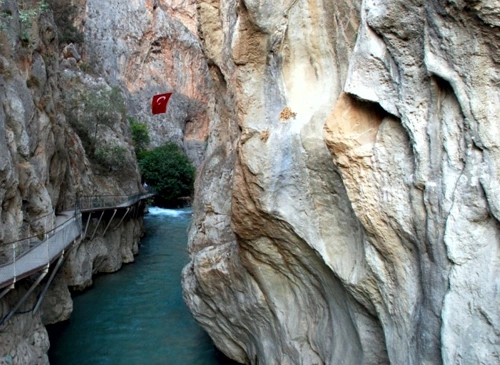
Saklikent
is a gorge cut deeply into the mountains of the Akdaǧlar Range, 30 kilometres
from Fethiye. A lot of visitors come to walk the gorge, which with its wooden
boardwalks allow access along the opening part of the trail jutting out high
above the river, at the end of this section the trail continues to be reached
by negotiating the swift-running river itself and then walking through the
narrow fissure to the end. At the mouth of the gorge you can enjoy the Cushion-strewn
tea platforms that jut out over the river if you don't fancy the challenge of walking
through the freezing cold water into the gorge itself. You can also take a canoe
or raft trip along the river for the more actively-inclined.
Lycian city of Pinara
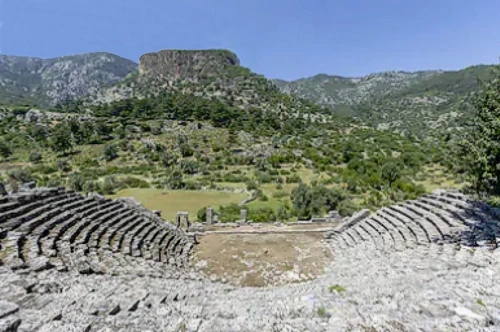
To
the southeast of Fethiye the ruins of the Lycian city of Pinara can be seen
located in a commanding position in the mountainous regions. The main interest
can be clearly seen by the honeycombed cliff of more than 900 rock tombs and
monolithic house tombs. The site was so inaccessible that the tomb-builders had
to be lowered on stages secured with ropes. The beautiful panoramic views that
surround the ruins is absolutely stunning, especially around the theatre area backdropped
by snow-topped mountains and surrounded by fertile pine forest. Due to its
location makes this is one of the quieter Lycian sites in the area and seldom
gets busy with tourists.
Letoön ancient Lycian city
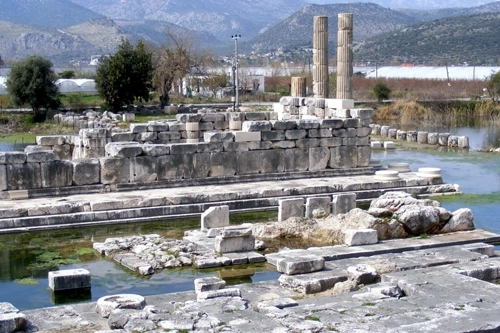
Letoön was a significant Lycian religious centre dedicated to the Greek goddess Leto, this is also a UNESCO (United Nations Educational, Scientific and Cultural Organization) protected site. Leto who according to Greek mythology was banished to Lycia by the god Zeus' jealous wife Hera after an affair with the great Greek god. There are three temples here that are dedicated to Leto and her twin children by Zeus, Apollo and Artemis. The site has an amazingly atmospheric feel about it with its well-preserved mosaic floor in temple of Apollo.
Xanthos
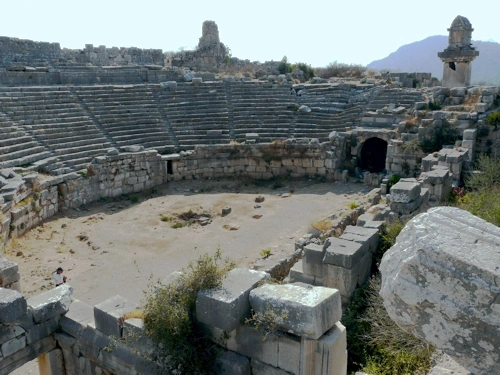
Xanthos
was the ancient capital of Lycia, which is sometimes called "the oldest
republic in the world." Xanthos ruled a group of 20 cities which was
governed by a popular assembly and a president. Although the site is now
protected by UNESCO, a number of Xanthos' most stunning monuments were shipped
to England in the 19th century. Some fine mosaics can still be seen in situ as well
as the theatre, agora, and acropolis. Beyond the Roman theatre is the plinth
that once held the Nereid Monument an ionic temple with fine sculptural adornment
(which is now displayed in the British Museum). The Hellenistic city gate, city
walls with extensive stretches are still visible, which may date back from the
3rd century BC.
Butterfly Valley
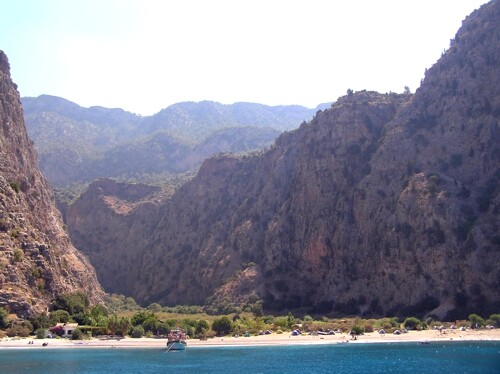
Butterfly
valley has an attractive beach, veiled between two very high sharp cliffs. As
its name suggests it is home to a number of butterflies including the Jersey
Tiger Butterfly. What makes this place magical is that it is unreachable by
road being only accessible by hiking there from Faralya village, high above on
the cliff, or taking a boat trip from Ölüdeniz. Great walking and hiking experiences
can be enjoyed through the lush forested gorge behind the beach, or simply relax
on the beautiful beach.
Tlos
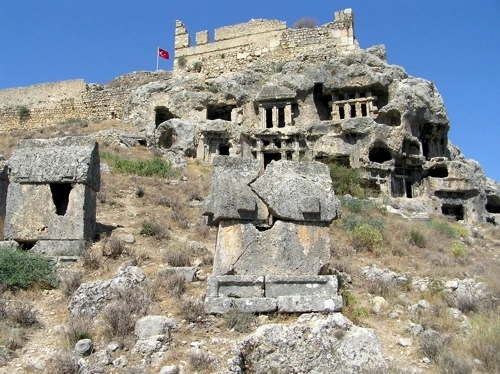
Elevated high up in the mountains that surround Fethiye is Tlos another Lycian city site. Crowning the rounded acropolis hill, here you can see the remnants of an Ottoman fortress. The Lycians weren't the only ones to take advantage of the advantageous mountain stronghold position and this fortress was used by numerous local brigands during the Ottoman rule. On the east side of the acropolis, the remnants of both the Lycian and Roman city walls can still be seen. Scattered ruins of houses, public buildings, including a hall-like structure (which may have been an indoor market), agora, necropolis, and a restored theatre give an vision of what it must have been like.
Patara

Patara
boasts Turkey's longest strip of sand beach, perfect for that day on the beach.
Here you will find a once important Lycian city with an abundancy of ruins close
to the beach area within easy walk should you wish to mix both beach and
history together. The entrance to the ruins of ancient Patara are through a
Roman period triple-arched gateway a well-preserved theatre is nearby with a
colonnaded street, bath complex, and abundancy of tombs. The city was used
right up to the Byzantine period and a basilica can also be seen. Patara has another
claim to fame as it's also the birthplace of St. Nicholas of Myra (modern day Demre,
near Kaş), a 4th-century bishop, who became "Santa Claus”.




